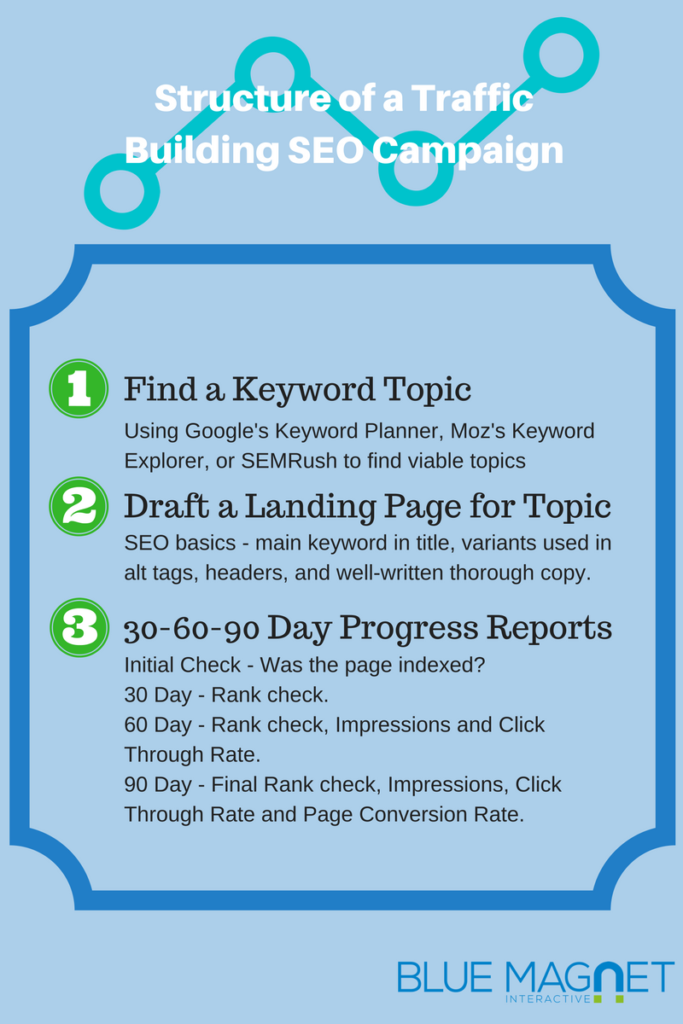Every SEO agency will say roughly the same thing in regards to search engine optimization – it is a never ending process. There is always something else to do, another link to build, another topic to optimize for, or another way to make the web pages load faster. They all say this even though you have a limited budget and your budget doesn’t include endless SEO work. Do you just let your SEO agency run through their standardized checklist of SEO activities and hope for the best or is there a better way to use your budget?
What is a SEO Campaign?
There are a few different paradigms for SEO. One is a completionist paradigm. This is a common method of performing SEO: running through a checklist. This is the kind of SEO you find on large websites with thousands upon thousands of pages listed in the search engines. The bulk of the traffic for these sites comes mainly from brand keywords and the SEO done on pages is about enhancing the url structure, optimizing how search engine bots crawl the site, and fixing how titles and meta descriptions use related keywords.
For these sites, a plan from a template generally works well. Each page goes through the same standard set of actions like a mass-produced commodity. This type of SEO works best when the site is already humming along. You are possibly allowing an automated auditing tool to analyze your pages and suggest fixes to align them with that tool’s definition of best practices.
Another paradigm to use is campaign based SEO. Campaigns are made up of a set of actions working together to achieve a specific agreed upon result. In SEO terms, the campaign would be a set of SEO tasks performed on behalf of the site to reach a goal. This type of SEO is best for smaller sites in competitive markets. When your budget restrains you from large PPC spends and the competition swarms over the first two pages of the SERPs for all the big keywords, you need to be spry, agile, and a bit of a guerrilla marketer.
Campaign based SEO is about setting a goal, defining and implementing the actions needed to achieve the goal, and finally analyzing the results of the actions to improve how the next campaign will be implemented.
An Example of a SEO Campaign for a Hotel
The easiest way to explain a SEO campaign is to run through a simple example.
Consider a hotel located in a metropolitan city. Most people visiting the area will be looking for a hotel in metropolitan city and getting the hotel to rank for the metropolitan city keyword will be difficult, especially if there are over 20 hotels in the city also trying to rank for the topic.
Setting the Goal
For the hotel to get traffic to its site, it will need to target other keywords for which it is relevant. This goal becomes the basis for a campaign.
Doing some keyword research will turn up phrases like “hotels near art institute of chicago”. The monthly average search volume may be low but when the search is performed, the SERPs are dominated by the competition, or, if the competition is there, their content lacks depth and usefulness. The goal of the campaign is to rank for keywords related to the topic “hotels near art institute of chicago”.

Identifying the Tasks to Achieve the Goal
A set of SEO tasks need to be identified to achieve the goal for the hotel. The first step is to see if the phrase is used anywhere on the hotel’s website. If the phrase cannot be found on the site, then it should be added in a logical place. Most hotel websites have a page describing the local area and this phrase would work on that page. Adding a few sentences about how the hotel is located near the attraction will be enough. This page will use the ‘hotel near art institute of chicago’ phrase to link to the new landing page being created.
The next step is to create a landing page built around the topic and make sure it is properly linked to from the site’s navigation. The page needs to be worthy of being in the top 10 search results on Google. This means analyzing all the results in the top 10 and identifying the opportunities. Does one of the sites listed in the top 10 have weak content? Maybe the best way to get in the top 10 is to offer content the other sites are lacking, like video, high resolution images, or an interactive experience.
The simplest way to make content better is to write in more depth and with greater thoroughness on the topic than anyone else. Make the content a resource on the topic. Make the content useful to the reader in a way no other site is doing.
The last step for this goal is to do some outreach and to get relevant websites to link to the new page created on the site. These links should come from sites with authority on the subject of the well-known tourist attraction or at the very least with authority on the region.
Essentially, does the site rank for terms related to the well-known tourist attraction? A tool like SEMRush can assist in quickly determining which keywords the site ranks for and whether it is a good candidate to link to the newly created landing page.

Moz.com tools, like Open Site Explorer, can also provide other pieces of data to determine if the pages is a good source for links, such as a link spam score and Moz’s own Domain/Page Authority.

A low Domain/Page Authority or a high link spam score is an indication the site might not be the best opportunity for a link, but that is a simplified analysis of those scores and anyone doing the link building should seek out other sources for a more indepth discussion on how to use Domain Authority, Page Authority and the Link Spam score in the link building process.
After these steps have been taken, the page needs to be monitored. The best practice is to check on the page in 30 days, 60 days, and 90 days. At the 30 day mark, the page should show up for well-known tourist attraction search terms as well as the targeted term “hotels near art institute of chicago”.
Google provides the Search Console with search analytics which gives a peek into what keywords the site is showing up for and which terms people are actually clicking through on. This is the single best report to see how well the site is performing in search for the topic.
Monitoring Success and Failure of Tasks
At the 30-day mark, adjustments might be made. Maybe more content is needed to flesh out the topic on the page. Maybe there are new linking opportunities or just better on-site marketing of the page is needed. For example, a banner image might need to be added to the home page to attract more clicks to the new page. At this time, if the hotel is doing social media marketing, linking to the new landing page on the social media channels could be helpful.
The 60-day mark is when the landing page should be on page one for some terms related to the well-known tourist attraction. If not, then a deeper analysis is needed and adjustments made. Is the site competing with other sites with much better domain authorities? Is the content weak compared to other options on the SERPs? Remember, the new landing page is competing with all the other pages on the SERPs and needs to be better than at least one of those pages in order to appear in search results.
When 90 days is reached, another check of the keywords is made and a final report is made. If everything was done correctly, the site is now on page one for the niche keyword and variations. This traffic is new for the site. These are visitors who wouldn’t have found the hotel website without the new landing page.
Wrapping Up the Campaign Example
The SEO campaign described above is an example of one type of campaign. Other types of campaigns depend on the goal being pursued, but in SEO the goal is either to increase traffic to the site or increase conversion on the site. Beyond those two elements is the distinction about the type of traffic being received, the sources of the traffic, and how the traffic interacts with the site.
The goals could then be focused on increasing site speed, making the site more mobile friendly, getting links from valuable referrers, or many other countless activities. Each activity, to be considered a goal, needs to have a metric attached to it, a metric a SEO agency can have an affect on.
The Basics of a SEO Campaign

- The Goal
- The goal needs to be reasonable, achievable, and measurable.
- The metrics to determine success need to be clearly established.
- The length of the campaign is established based on the goal.
- The Actions
- Before doing anything, the set of actions to be taken to achieve the goal need to be defined and a clear explanation about how these actions will help in achieving the goal needs to be made.
- A benchmark needs to be taken. Whatever element being measured for the goal needs to be measured and noted. This is the only way to determine if the campaign was successful and the degree of success.
- The defined actions for the campaign need to be taken quickly. Implementing the components of the campaign within the same month will help in measuring the success of the goal while limiting the effect of other variables on the site.
- The Results
- The metrics related to the goal are measured at the agreed upon end of the campaign and compared to the original benchmark to determine the overall success of the campaign.
How Does Campaign Based SEO Help Hotels?
The real benefit of campaign model for hotels is the targeted effort allows hotels to determine if their marketing agency is adding to their bottom line. An agency going through a checklist of SEO activity may spend time on an area the site is already doing well. The hotel ends up paying for a service adding no demonstrable value to the site.
Does the site appear in the local 3-pack for all the major search terms related to the hotel? If so, is it worth spending more time building local citations or should time be spent building additional traffic with niche keywords? What about the pages on the site with a high bounce rate or converting below the site average? Maybe this is the time to dig into some conversion optimization for the site.
With a limited budget, a hospitality business needs every marketing dollar driving results for the hotel. A large business with a marketing staff to keep busy can waste time pursuing diminishing returns. Those people are going to be paid anyway so there isn’t any reason not to pursue every minor tweak to a site. A business with a tighter budget needs to make sure every hour spent on marketing is delivering the best possible value.
Another benefit from using SEO campaigns for hotels is how agile it is. The needs of any business are dynamic and the SEO strategy should be able to adapt to those needs. Is the hotel lacking in wedding business? Then a SEO campaign focused on driving wedding based searches to the website can be created. These goals can be adjusted month-to-month, built on over time, and the reported results are meaningful.
Common Questions Asked About Campaign Based SEO
Does every SEO campaign meet its goal?
No. Because digital marketing takes place in an ecosystem with many variables beyond the control of the business or the marketing agency, there are factors which can prevent a campaign from meeting its goal.
Goals help define the actions to be taken, and it is possible not enough time was scheduled to meet the goal or some other factor interfered. Not every football play scores a touchdown, and even if the point of the play was to reach a first down, at times it is good to just move the ball forward. The goal helps identify what ‘forward’ is for the site.
Do you abandon other SEO maintenance activity to focus on the goal?
No. Monitoring the site for errors, poor quality backlinks, server issues, mobile responsiveness issues, and speed issues needs to be an ongoing process. These activities are at the core of maintaining the health of the website and cannot be ignored. Some part of the marketing budget will always have to go towards these activities for the sake of the site. Without these elements in place, all other SEO activity on the site will be less effective.
What if there is ever only one goal, make more money?
Okay, yes, making money is the primary goal of most websites. SEO campaigns are focused on helping the site make more money. Building traffic, increasing conversion, lowering bounce rate, building efficient funnels on the site, and increasing site authority are goals leading to more money and are goals SEO agencies have the most control over through site architecture, content, and links.
No matter what the SEO goal is, there should be a clear path between the action taken on the site and how it relates to bringing in more money. Driving more traffic to pages on the site that convert well will lead to more reservations. Lowering bounce rate on a page sends a quality signal to Google which will lead to higher rankings, and more traffic. Improving conversion rate on a page will squeeze more reservations from the existing traffic. Creating efficient funnels on the site will lead visitors from pages attracting the visits to pages with a better conversion rate.
Is Your Hotel Website Ready for A Campaign?
When you are ready to get more out of your SEO, contact us and see how campaign based SEO can immediately improve your hotel website’s performance. Book more rooms, get more group business, or get more from the visitors already coming to the site.
Blue Magnet’s high-touch digital marketing service allows us to understand the needs of your hotel and pinpoint the SEO tasks needed to create the best return on your marketing budget.




